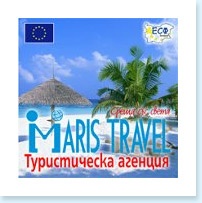English

About us:
“MARIS TRAVEL” LTD is a travel agency set up in 2012.The word “Maris” derives from one of the Latin names of the nearby flowing Maritsa river meaning “a river going to the sea”.The company is based in Plovdiv - the second largest town of Bulgaria and one of the oldest settlements in the world.
“MARIS TRAVEL” LTD is a licensed tour operator and travel agent.Our permit is: PK-01-7205 issued by the Ministry of Economics and Tourism.It enables us to provide tourist and travel services to domestic and foreign customers.
We offer:
# planning and organization of trips and tours in Bulgaria and/or abroad
# holidays and vacations in major Bulgarian or foreign destinations
# hotel booking in Bulgaria or abroad
# airline tickets all over the world
# bus tickets all over Europe
# cruises
# travel insurance services
To our foreign customers we offer also airport pick-ups and other transfers, accommodation in hotels or guest houses, customized tours, transport and guide services.Our tailor-made travelings about Bulgaria observe totally the interests, time and budget of our clients and vary from visiting cultural and historical sights to many different kinds of vacations: seaside, ski, wellness and SPA, rural tourism, golf, hunting and fishing, etc.
Contacts:
Address: Bulgaria, Plovdiv, 19 “Sredets” str., office 3
Telephones: 0359 32 940 700 mobile: 0359 32 876 203 230
Fax: 0359 32 940 700
Emails: office@maris-travel.com maris_travel@abv.bg
Skype: maris_travel
Facebook: Maris Travel
Office opened: Monday-Friday 9.30-18.00
Manager: Mrs Lilia Ilinova
About Bulgaria:
Capital: Sofia
Geographical size: 111 002 km²
Population: 7 245 677 (2014)
GDP: € 42.011 billion (2014)
Official EU language(s): Bulgarian
Political system: parliamentary republic
EU member state since: 1 January 2007
Bulgaria (България) is a country in the Balkans on the western side of the Black Sea. It is surrounded by Romania to the north, Serbia to the northwest, the Republic of Macedonia to the southwest, Greece to the south, and Turkey to the southeast. Being located close to the Turkish Straits means the key land routes from Europe to Middle East and Asia pass through Bulgaria.
Bulgaria is one of the few exotic nations of Europe, due to the fact that it boasts sublime beaches, lovely churches, winter sport opportunities, to name a few. Although it is not regularly visited compared to other European nations, it is a beautiful place, with a wide range of activities for a traveller to do.
Climate
Continental in the interior; cold, damp winters with snow in the higher elevations; hot and humid summers.
Temperate on the coast; mild autumns, cool winters, mild springs and warm and breezy summers.
Terrain
Mostly mountains with lowlands in north and southeast; highest point : Musala 2,925 m
History
A branch of the Slavs merged with the proto-Bulgars and the indigenous Thracian tribes in the late 7th century to form the first Bulgarian state in the Balkans.
In succeeding centuries, Bulgarian and the Byzantine Empires dominated South-East Europe, but by the end of the 14th century the region was overrun by the Ottoman Turks. Bulgaria regained its independence in 1878 largely due to the intervention of Russia, who clipped the wings of the declining Ottoman Empire in Bulgaria and elsewhere, and installed a minor German prince as a ruler of the newly independent country. The country's iconic heroes were all freedom fighters such as Rakovsky (Раковски), who mixed revolution and literature, Vassil Levski (Васил Левски) - the Apostle of Freedom, or Hristo Botev (Христо Ботев), poet and fighter.
After a series of bloody and brutal Balkan wars, Bulgaria had the further misfortune to be an ally to the losing side in both World Wars, and was occupied by the Soviet Union and became a People's Republic in 1946. Communist domination was brought to a swift, but for many people illusory end in 1989; though Bulgaria went on to hold its first multi-party election since World War II, essentially socialist policies were pursued until hyperinflation and economic meltdown drove the old guard out of power in 1997. Today, reforms and democratization have brought Bulgaria into the NATO fold, with EU accession celebrated in 2007.
During Communist times, the Black Sea was a favorite destination for travellers behind the Iron Curtain. Now, increasing numbers of western Europeans travel throughout the country and many have bought vacation houses near the Black Sea or in picturesque villages. During the 2008 global financial crisis, Bulgaria marked a decline in its economy of 5.5% in 2009, but quickly restored positive growth levels, in contrast to other Balkan countries. That said, the Bulgarians have the distinction of boasting the strongest and most stable currency in Eastern Europe.
Despite significant economic advances, the country is the poorest member of the European Union. The Issues facing the country are a weak judiciary system, a moderate level of corruption in the local government, a poor road infrastructure, and a somewhat high unemployment rate. The unemployment has continually lingered near the double digits, an issue has historically faced. Another serious problem is the sight of over-development in the country.
Language
The Bulgarian language is related to Serbian, Russian and other Eastern European languages, but contains many international words. Bulgarians use the Cyrillic alphabet which can make the task of getting around the country somewhat difficult if you aren't familiar with this alphabet as most signs are written in it. However, getting acquainted with the alphabet isn't very difficult and may save you a lot of trouble, especially as many common words are homophones of English or French words.
Also, as Bulgarian education emphasizes foreign language studies, especially English language, it wouldn't be a problem to talk and find information in English in bigger cities. It's best to turn to the young population for a direction or an advice.
Holidays
Baba Marta (Martenitsa/Баба Марта) (Grandma Marta), March 1. A very old Bulgarian holiday. People give each martenitsa (мартеница), a type of white-red yarn, as a symbol of health. (this is not a public holiday)
March 3 (Трети март). The day Bulgaria celebrates its liberation from 500 years of Ottoman domination (1393-1878).
20th of April - 20 April 1876 is the official start day the greatest uprising of the Bulgarian people against the Ottoman rule.
Gergiovden (Гергьовден), May 6. St. George and official holiday of the Bulgarian Аrmy.
Ss. Cyril and Methodius Day (Ден на Кирил и Методий), May 24. The day of St. Cyril (827-869), and St. Methodius (826-884), who created the Cyrillic alphabet. A beautiful holiday - with lots of flowers, music, and joy.
Assumption Day - Golyama Bogoroditsa, August 15. There are big celebrations, especially in the main monasteries, with icons being paraded by the monks. (this is not a public holiday)
Reunification Day (Ден на съединението), September 6. The day the two parts of Bulgaria, Principality of Bulgaria and East Rumelia (autonomous in the Ottoman Empire) were reunited.
Source:www.wikitravel.org
About Plovdiv
The Old town of Plovdiv
Plovdiv, Plovdiv region
This is one of the oldest European towns contemporary to Troya and Mikena. It has been existing as a settlement about 8000 years ago, and became a town 3000 years ago during the Troyan war. There are very well preserved artifacts of the Bulgarian Revival architecture – a variety of archeological memorials from Thracian, Romanian and Medieval times.
More ancient than Bulgaria itself, this singular city preserves vivid memories of its turbulent and dramatic fate. In 342 B.C. Philip II of Macedon conquered the Thracian town of Evmolpia giving it his name - Philippopolis. At the start of our millennium the Romans conquered Thrace and called the city Trimontium.
During the 19 th century Bulgarian master builders erected the National Revival town of Plovdiv (the Old Town) with steep cobbled lanes, lovely houses with large bay windows and slender columns, latticed eaves and heavy oak gates, quiet green yards and rippling marble fountains. Every house here has its own style and atmosphere. Situated on three hills in the Thracian Plain, encircled by the slow running waters of the Maritsa River, Bulgaria’s second largest city today, Plovdiv has a 24 centuries long history and is one of the ancient crossroads between East and West. Landmarks remaining from Roman times include the Philippopolis Amphitheatre and the restored 2 nd century Antigue Theatre. The Ethnographic, the art galleries, churches and the street of folk arts and crafts are major landmarks of Old Plovdid. The Old Plovdiv on Trimontzium hill is famous of its National Revival architecture (from 18 th-19 th centuries).
Many of the houses are now museums:
• the Ethnographic museum
• the Museum of the National Revival and the National Liberation struggles
• the Museum “Balabanov’s house”
• the Hindilian's house
A lot of the churches are very interesting too:
• the Church “St. St. Konstantin and Elena”
• the Cathedral church “The Holy Mother”
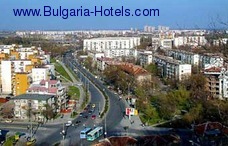
City, Plovdiv region
The town of Plovdiv (376 276 inhabitants, 160 m above sea level), is situated in the western part of the Upper Thracian valley. The town is located 150 km from Sofia, 19 km from Assenovgrad, 102 km from Smolyan, 90 km from Stara Zagora. It ranks as the second Bulgarian city in population and size after the capital.More info
Monastery, Plovdiv region
Bachkovo Monastery is located on the right bank of the Chepelare river, above the Plovdiv-Smolyan road, 29 km away from Plovdiv, 89 km away from Sofia and 10 km away from Assenovgrad, it is not far from Pamporovo mountain resort.More info
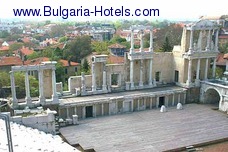
Historical site, Plovdiv region
The ancient theatre in Plovdiv town is the most impressive building of Roman time that has come to us. It took more than ten years to clear the site and remove the 15-metre thick layer of earth, which was covering the theatre. The spectators’ seats were amphitheatrically shaped and divided into two rings of 14 rows each. Most probably ...More info
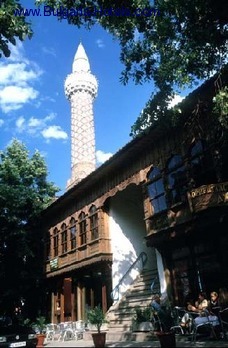
Church, Plovdiv region
Djumaya Mosque, known also as Ulu Mosque, is a precious architectural monument in the center of Plovdiv that gives an idea of the old settlement of Filibe. It is one of the biggest and the oldest mosques in Bulgaria. It is called Djumaya (from Turkish – Friday), because the service was held in Friday. It is believed to be built ...More info
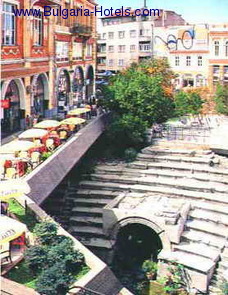
Historical site, Plovdiv region
Under the nowadays Shopping center in Plovdiv, is located the magnificent Roman stadium. Its rostrums were built over the Sahat tepe and Taxim tepe (hills). The stadium has the shape of a horseshoe and is 180 meters long and there are 30 000 seats. Some archeologists think that games from the Septimus Severus time (193 - 211) took ...More info
Museum, Plovdiv region
The Golden Treasure of Panagyurishte dates to the end of 4 th and the beginning of the 3 century b. c. It was found in 1949, two kilometers from the town of Panagyurishte. It consists of nine ritual utensils made of pure gold and weighs 6 kg.More info
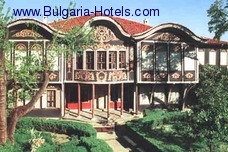
Museum, Plovdiv region
The Etnographic Museum in Plovdiv is one of the most interesting museums in Bulgaria. Its exhibits are on show in a beautiful house, which is a fine example of the Bulgarian Baroque architecture of the National Revival Period. It was built in 1847. The principal facade of the house faces west, giving onto a spacious and well-kept ...More info
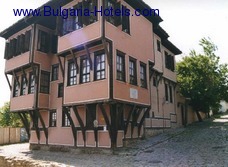
Historical site, Plovdiv region
There are several 'National Revival' style mansions of the Bulgarian Renaissance which characterise 'Old Plovdiv'. This one is The House of Georgi Mavridi where the French poet Alfonse de Lamartin lived in 1833. Also known as Lamartin's House or "the house of writer's". Today it houses the creative fund of the Union of Bulgarian ...More info
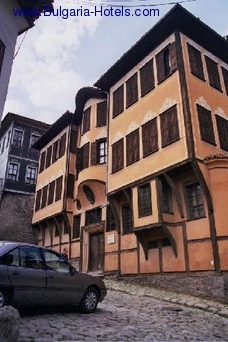
Museum, Plovdiv region
Designed and built by the master architect of National Revival mansions, Haji Georgi in 1846, this ochre house seen in the picture was built for the wealthy Plovdiv merchant Dimitur Georgiadi. The overall outer design is symmetrical with ornamented facade's, whilst the interior has beautiful wood-carved ceilings and intricate profiles ...More info
Source:www.visitbulgaria.travel
BULGARIAN UNESCO SIGHTS:
|
Bulgaria in UNESCO World Heritage
Bulgaria is a country with over than 13 century old history. The great number of unique monuments and archaeological findings remind of its rich historical past – antique towns, tombs and sanctuaries dating back to the Thracian, Greek and Roman times. The medieval fortresses, necropolis and monastery complexes are witnesses to the power of the First and the Second Bulgarian Kingdoms. On the country’s territory there are nine sights, which are included in UNESCO`s list of World Cultural and Natural Heritage.
|
||||
 |
The Bojana Church
The church is among the most significant monuments of Bulgarian Medieval architecture and icon paintings. The painted in bright colors unique frescoes are vital and realistic, and are considered as some of the masterpieces of European medieval art. The church is located about 8 km away from Sofia city center. |
|||
 |
The Ivanovo Rock Churches
It is a rock monastery complex of monk cells, situated on both sides of the River Lom, about 18 km from the town of Ruse. The walls are covered with paintings of Bible scenes and compositions with numerous figures. The partially preserved frescoes testify to the remarkable achievements of the Bulgarian Medieval School of art. |
|||
 |
The Thracian Tomb in Kazanlak
It is one of the most famous monuments of the Thracian culture, included in the List of UNESCO. The tomb is dating back to the end of the 4th and the beginning of the 3th centuries B.C. It consists of an antre-chamber, a corridor and a burial chamber. The mural paintings in the burial chamber and in the corridor are of exclusive artistic value. The tomb is located on the Tyulbeto Hill in the north-eastern part of the town of Kazanlak. An exact copy has been made nearby, designed for visitors. |
|||
 |
The Madara Horseman
This is a rock relief cut at a height of 23 m on to the almost vertical Madara rocks. It is the only one of its kind in Europe. Тhe monument symbolizes the victorious campaign of the Bulgarian rulers during the Middle Ages, about 3 decades after the foundation of the Bulgarian State. The Madara Horseman is about 16 km away from the town of Shumen. |
|||
 |
The Old Town of Nessebar
Nessebar is one of the oldest towns in Europe. The old part of the town, built on a picturesque peninsula, has been declared architectural, historical and archaeological reserve. Impressive traces of old Greek, early Byzantine and medieval fortress walls can be seen all over the small island. The churches in Nessebar are the symbol of the town. During the Middle Ages there had been built about 40 churches, which represent the rich architectural heritage of the Eastern Orthodox world. |
|||
  |
The Rila Monastery
It is the biggest and the most famous monastery in Bulgaria. It is located in the skirts of the Rila Mountain, at the altitude of 1147 m. The entire complex is quite impressive for its size. The 4 floor residential part consists of no less than 300 cells, 4 chapels, a kitchen, a library and guestroom for donors. The exterior is no less intriguing for its high and severe stone walls cut through by small windows – reminding of a military fort rather than a monastery. The monastery was founded in the 10th century by the hermit Ivan Rilski, whose relics are exhibited for pilgrims in the main church. St. Ivan Rilski lived in fact in a cave about half-an-hour walk away from the present monastery. The Rila Monastery has enjoyed great respect and privileges ever since it was established. For instance all the Bulgarian tzars made generous donations to it. The official support helped the monastery grow into a cultural and religious center. |
|||
 |
The Tomb of Sveshtari
It is a Thracian tomb of the first half of the 3rd century B.C. The discovered in 1982 tomb has a unique architectural decor with polychrome half-Hyman, half-plant caryatids and painted murals. The Svestari tomb reflects the fundamental structural principles of Thracian cult buildings. It is near the village of Svestari, 7 km to the northwest of the town of Isperih. |
|||
 |
Pirin National Park
It takes up a significant part of the marvellous Pirin Mountain. The park covers an area of about 40 333 hectares and treasures an enormous variety of forest, sub-alpine and alpine eco systems, as well as the beauty of all forms and shapes of the alpine relief. |
|||
 |
Srebarna Reserve
The Nature Reserve is situated in the northeastern part of Bulgaria, near the village of Srebarna, about 18 km from the town of Silistra and 2 km from the River Danube, on the Via Pontica – a bird migration route between Europe and Africa. The biosphere reserve includes the fresh water lake Srebarna and its surroundings. It covers an area of about 600 ha and is the breeding ground of almost 100 species of birds, many of which are rare or endangered. |
|||





















